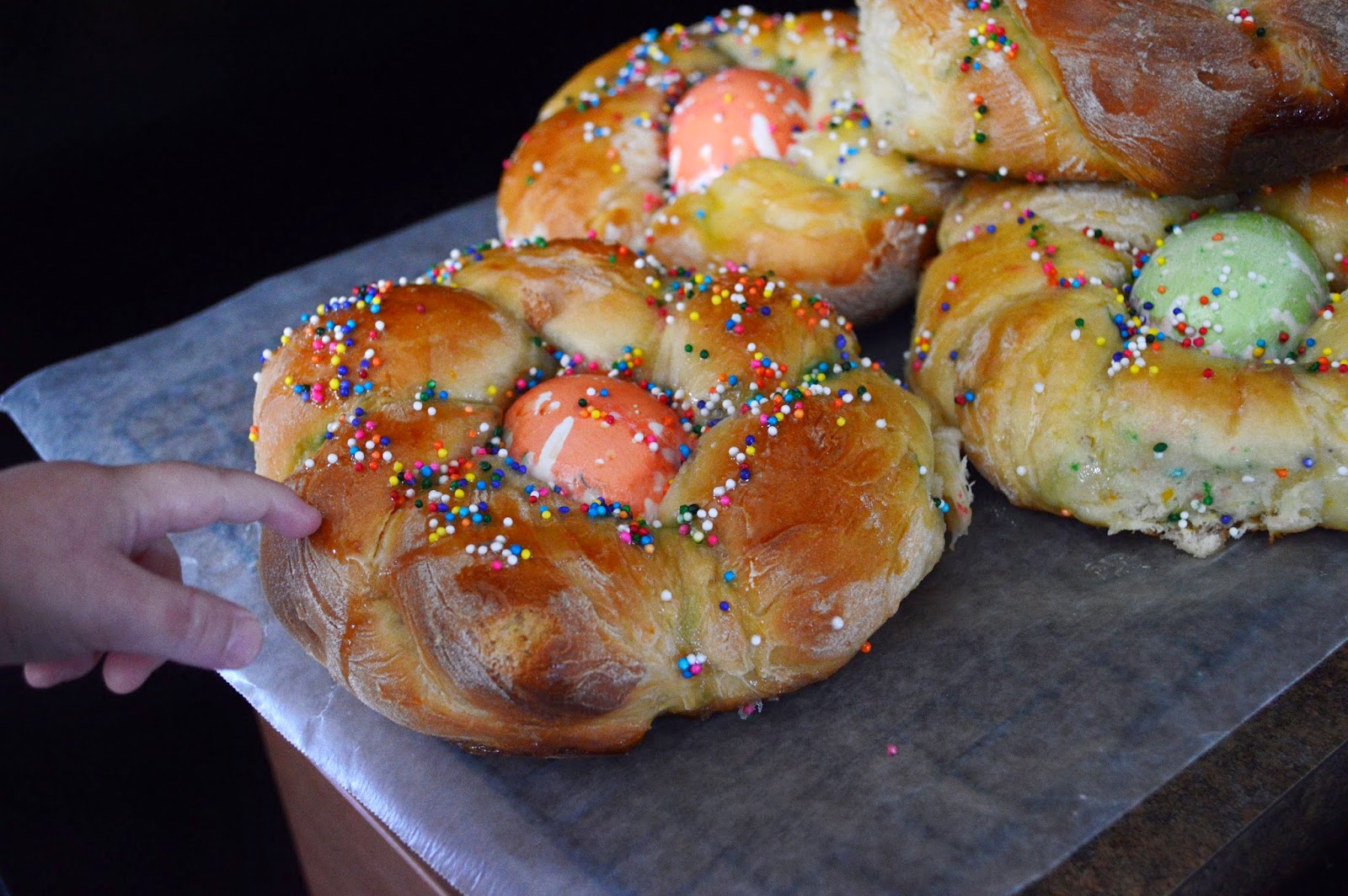To celebrate Easter this year, I decided to make some traditional Italian Easter Bread (baby fingers not included). I wanted to deliver sweet treats to our neighbors and also invite them to Sojourn for our Easter service, but I also wanted to make a recipe with some significance. Growing up, we would eat Pane di Pasqua every year at Easter--not usually homemade (my mom wasn't much of a baker), but I found the store-bought version to be just as tasty. Thank you, Publix. I will forever miss you.
I found a recipe online that I liked, but I wasn't quite sure if I could use it, since I don't have a stand-mixer with a dough hook attachment. So I called up my grandfather to double check. His response: "Ash, did your great-grandmother have a fancy mixer to make bread dough in the countryside of Italy?" Touche, Pepa, touche. Levi and I would go old-school and mix by hand.
I tweaked the recipe just a bit, since traditional Pane di Pasqua usually includes a citrus flavor, as well as some anise. I didn't have any anise on hand, so I used a splash of vanilla extract instead. I also chose to add some orange zest to my dough, to follow tradition.
Here is what you will need to make 6 individual loaves:
- 1 package active dry yeast
- 1.25 cups scalded milk, cooled to room temperature
- pinch of salt
- 1/3 cup butter, softened
- 2 eggs, beaten
- 1/2 cup sugar
- zest of one medium orange
- 1 tsp vanilla extract
- 5 cups flour (approximate)
- 1 egg, beaten with 1 teaspoon of water
- 6 dyed Easter eggs
- 1 cup confectioners sugar
- sprinkles
Tip: the Easter eggs do not need to be hard boiled. They cook when the bread bakes. Levi and I dyed the eggs right out of the fridge, without hardboiling them.
Instructions:
In a large mixing bowl, combine yeast, warm (not hot) milk, salt, butter, eggs, sugar, orange zest and vanilla extract. Add about half the flour and beat until smooth (either with a stand-mixer or by hand). Slowly add the remaining flour to form a stiff dough. Don't worry about how much flour it ends up being, just keep adding until the dough is not sticky anymore. Knead until smooth with either dough hook attachment or turn out on floured board. Place in a greased bowl, cover and let rise in a warm place until doubled, about 2-3 hours (if you use Rapid Rise yeast, you can cut this time in half).
I also have to give some mad props to my great-grandmother, Angelina. Mixing dough by hand is not easy work--it requires some muscle. I couldn't imagine having to do so multiple times per week for a family of 6.
I also have to give some mad props to my great-grandmother, Angelina. Mixing dough by hand is not easy work--it requires some muscle. I couldn't imagine having to do so multiple times per week for a family of 6.
 |
| The dough before resting. After rising, it nearly filled the bowl. |
Once it has risen, punch the dough down and divide it into 12 pieces. Roll each piece to form a 1 inch thick rope about 14 inches long and, taking two pieces, twist to form a "braid", pinching the ends and looping them into a circle.
 |
| (It might also be helpful to recruit a 16 month old to make a floury mess and taste test the raw dough.) |
 |
| I doubled the recipe to make 12 loaves--enough to give to neighbors and friends. Worked great! |
Place on a greased baking sheet or line your baking sheet with parchment paper. Cover and let rise until double, about 2 hours again. Brush each bread with beaten egg wash. In the middle of each bread ring, gently place an Easter egg. Bake in a preheated oven at 350 degrees for about 20-25 minutes, or until golden in color.
Meanwhile, combine 1 cup of confectioner's sugar with 1/4 cup of water in a small saucepan. Heat on the stovetop until the sugar is melted and smooth. Once the loaves are removed from the oven, immediately drizzle the sugar mixture over the top and add the sprinkles.
That's it! Italian Easter Bread.
Happy Easter, friends! May we never forget the living Christ who gives us reason to celebrate.
Happy Easter, friends! May we never forget the living Christ who gives us reason to celebrate.









No comments:
Post a Comment